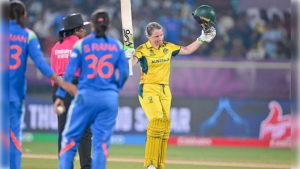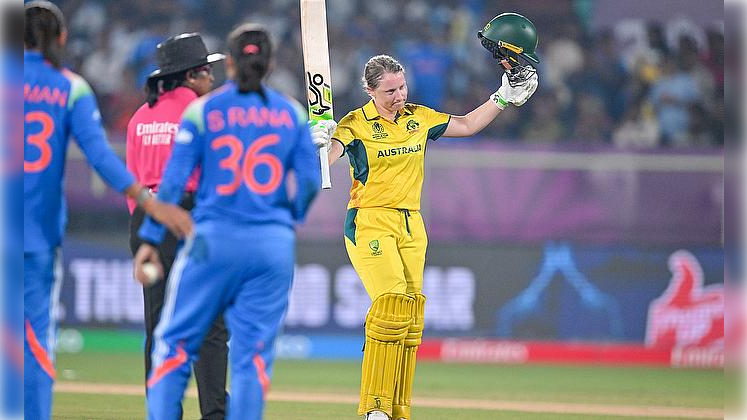
By Trisha Ghosal in Vizag
It poured in Vizag the moment the match ended, almost as if the skies themselves couldn’t bear India’s heartbreak. Two matches. Two collapses. Two defeats that now leave India’s World Cup campaign hanging by a thread. Against the might of Australia, the hosts once again faltered in the moments that mattered most. Here are five reasons why India lost, not just the game, but the control of their own destiny.
1. The Rigidity in the Batting Order
This defeat began long before the final wicket fell, it began in the dugout. India’s stubborn insistence on sticking to a fixed top five cost them the very momentum they desperately needed.
When Smriti Mandhana and Pratika Rawal finally gave India a launchpad at 155 for 1, it was the perfect moment to send in the power-hitters, Richa Ghosh, Harmanpreet Kaur, or Jemimah Rodrigues, the batters built to accelerate. Instead, the management chose to ‘protect rhythm’, as head coach Amol Muzumdar later explained, and retained the order unchanged.
Australia, with batting depth stretching till No.10, treat aggression as insurance, not risk. India, meanwhile, played it safe and safe cricket rarely wins World Cups.
2. The Collapse of Partnerships
One-day cricket thrives on partnerships, India, however, seemed to forget that fundamental principle. After the opening stand, no one took responsibility to build another. Beyond the 155-run stand between Smriti and Pratika, the rest of the innings produced only fleeting 20s and 30s, with the Jemimah–Richa partnership of 54 being the only exception.
In contrast, Australia stitched their chase brick by brick, Healy and Litchfield added 85, Perry and Healy 69, Healy and Gardner 95, and finally Perry and Garth 28 off 23. When one batter fell, another took charge. India’s middle order, by contrast, withered under pressure.
At 302 for 5 in 44 overs, India looked set for 350. Instead, they limped to 330 in 48.5 overs, losing five wickets in 29 balls and adding just 28 runs. Partnerships win games and India simply didn’t build enough of them.
3. The Imbalance in Bowling Options
Four-and-a-half bowlers, that’s what India effectively fielded in a must-win World Cup game. While Amanjot Kaur’s late wickets were commendable, she is not a strike bowler with the new ball. That role belongs to Renuka Singh Thakur, the very bowler who has repeatedly dismissed Alyssa Healy with her in-swingers.
For More Exciting Articles: Follow RevSportz
Leaving Renuka out was a tactical blunder that dulled India’s attack. Kranti Gaud had an off day and that happens. But when one frontline bowler struggles, another must step up. Australia have that cushion; India don’t, simply because they chose not to.
Bowling partnerships are as vital as batting ones, and India’s lack of depth and flexibility was exposed yet again when pressure mounted.
4. The Absence of Game Awareness
If there’s one thread running through both of India’s defeats in Vizag, it’s their fading game awareness. The inability to play out their full quota of overs, the lack of clarity in decision-making, and the failure to calculate situations, all point to a deeper, worrying pattern.
When you’re 330 all out with seven balls remaining, that’s seven potential singles, or even one boundary, wasted. Those extra six to ten runs could have forced Ellyse Perry to take the chase into the final over, where anything might have happened.
Even smaller lapses, like Richa taking a single to expose the tail in the final over against South Africa, reflect muddled thinking. These aren’t lapses of luck; they’re lapses of judgement. And in World Cups, such moments decide who survives.
5. Losing the Big Moments, Again
This is the hardest truth to accept. India are good enough. This squad has 15 match-winners. Yet when the pressure tightens, India blink first. Against South Africa, they failed to close. Against Australia, they did it again.
This isn’t about skill, it’s about nerve. Ellyse Perry’s six off the final ball of the 49th over captured precisely what India lacked: clarity, courage, and composure when it mattered most. The same pattern unfolded in the 2024 T20 World Cup in Dubai, and now, it’s resurfacing in 2025.
The Road Ahead
India’s path from here is steep. They must win all three remaining matches to guarantee qualification or at least two and then hope other results go their way. England, New Zealand, and Bangladesh await, each carrying the weight of India’s hopes.
This team has the talent, the heart, and the support. But unless they learn to seize key moments, adapt mid-game, and abandon their self-inflicted rigidity, India risk falling short once more, in their own backyard.
The heartbreaks in Vizag weren’t born of misfortune. They were born of choices. And India have only themselves to blame for the corner they now find themselves trapped in.






